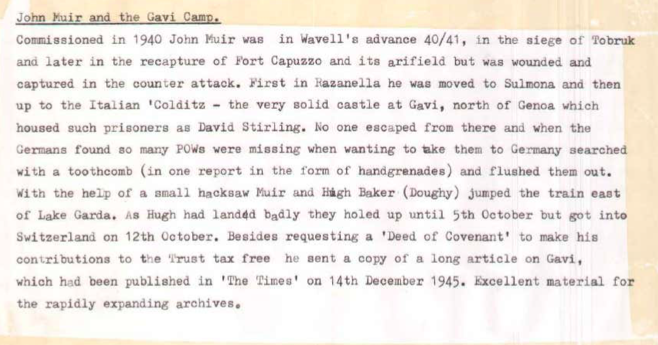John Muir
Lieutenant, Durham Light Infantry
John fought on the Egyptian border under the command of General Archibald Wavell as a lieutenant of the Durham Light Infantry, taking part in Operation Brevity (May 1941), which led to the reconquest of Fort Capuzzo by the British. During the following counter-attack, however, he was wounded and captured.
After receiving first-aid assistance from the Germans, he was moved to an Italian hospital in Benghazi. Then, leaving from Tarhuna, South of Tripoli, he reached Naples. Here he took a train, with other prisoners, to PG 17 Rezzanello (Piacenza). When they arrived, however, they discovered there were not enough beds for all of them, and four of them had to be transferred to PG 78, Sulmona.
John, who was constantly looking for an opportunity to escape, volunteered to be one of the four. During his stay in Sulmona, at the end of 1941, he took part in an escape plan involving digging an underground tunnel.
After cutting through the concrete floor we dug a shaft 20 feet deep and tunneled about 35 yards out from the hut and under the road running outside of the camp. We had about 10 yards to go to reach a suitable place at which we could ascend when one afternoon the Italians rushed in, went straight to the toilet area and there lifted the trap door leading to the shaft. I was working at the face at the time.
The first page of John’s recollection of his experience as a pow in Italy
(Fonte: MSMT Archive: <https://archives.msmtrust.org.uk/pow-index/muir-john/>
In May 1942, he was transferred to PG 35, Padula, with some other prisoners. Here too, he tried to escape, but he failed to find support among the other PoWs. Nevertheless, he tried to enact his plan, climbing on one of the shacks’ roofs, but he was discovered.
One month later, because of his bad behaviour, he was transferred again to PG 5, Gavi, a maximum-security camp in an ancient fortress nicknamed “the Italian Colditz” reserved for the most “unruly” prisoners. However, not even this new situation dissuaded John: with his cellmates, among them Hugh Baker and Trevor Neuendorf, he started planning his escape once more.
The scheme involved the lifting of the metal platform in one of the toilets, digging into the unused dungeons which we knew lay below the row of cells and seeing where we could go. It took about a month to remove the platform and dig down alongside the sewage pipe through the roof into the dungeon. We were disappointed to find that the walls at the back and far end of the dungeon were the solid rock on which the fortress was built. The other side wall had a bricked up doorway from which we removed enough bricks to get into a passageway leading to another bricked up doorway. We bored a hole through this doorway, which we found opened onto a walkway, which was in constant use by the Italians. This left us with the front wall of the dungeon. We removed 3 heavy stones and started to tunnel under the courtyard of our cell compound towards the outer wall of the fortress. We had gone only 7 or 8 feet by 8th September 1943.
At the proclamation of the Armistice, the prisoners were told to stay inside the fortress and wait for more news. However, the Germans took control of the camp during the following days and ordered them to gather their belongings and prepare to depart. John and his comrades decided to climb down into the dungeons discovered during their diggings. The disappearance of 50 men alerted the Germans, who, with a map, combed through the fortress until they found them.
After his recapture, on 16 September, he was transferred, with the rest of the prisoners, to Piacenza, then to Mantova, and then loaded on a train. John, with Hugh, was kept separated from his companions. As the convoy departed, the 20 men in his wagon started working on cutting an opening in the wooden frame. After stopping in Verona, near Ala (Trento), John and Hugh jumped down from the moving train and ran into the woods, crossing the Adige River with some difficulties. Once out of the water, they realised they were not in good shape: John was covered in bruises on his legs and arms, and his clothes were ripped, while Hugh had sprained his lower limbs and had difficulties walking.
Despite their doubts, they decided to knock on the door of a nearby hut to ask for help. The woman inside invited them in and tended to their wounds. She told them that there were also some Slavic PoWs in the area, and they soon showed up. Thanks to them, they found a place to stay in the village of Avio (Trento) in Emilio’s home. They remained with his family until 2 October, when Hugh’s knee and ankle healed. It was time to resume their journey:
We had been ‘kitted out’ with Italian clothing and received a 1932 road map so we were keen to get on our way. We left letters with all our Italian friends addressed to the British Authorities advising of the great help we had received.
They planned to reach the Garda Lake, steal a boat, and cross towards Como, where they counted on finding help.
They reached Torbole (Trento), but the village was teeming with Germans, and they were forced to fall back to Nago, finally entering Arco, which they discovered, to their surprise, was a “hospital city” with «Red Crosses everywhere and many wounded German soldiers». After taking refuge in a monastery, they left the area, reassessing their plan.
Having decided that Como was out of the question we decided that we would try for Switzerland at its nearest point (near Tirano) especially as the area ahead did not seem to be heavily populated – little did we realise this was because it was so mountainous as we soon found out and worse still we found that all the valleys were at right angles to our route.
It was 7 October 1943. After leaving Arco, they took a steep and challenging mountain path. In the late afternoon, under torrential rain, they reached the village of Brione (Trento). Here they knocked on the door of a house. A couple greeted them, invited them in, and provided towels, dry clothes, and food. The following day, the couple’s son, Silvio, a 13-year-old boy, guided them on a safer route. They kept marching across valleys and paths until they reached Capo di Ponte (Brescia). They came across a German automobile on 11 October near Edolo, but they were not spotted. They found refuge at a farm for the night. Hugh asked the farmer and his son, who were hosting them, to guide them toward the Swiss border, but they refused. They told them, however, that the border was indeed nearby: they needed to cross the Mount Combolo.
On 12 October, they left at four in the morning and followed the street to Tirano, reaching the mountain by foot around 8 pm. After the climb, they caught sight of a boundary stone made of concrete bearing the name “Switzerland” in the early afternoon.
We started to walk into Switzerland but with one accord and without a word to one another we turned walked back into Italy joined hands and jumped over an imaginary line between two of the blocks.
Childish expression of our joy at being free after nearly 30 months of captivity […].
I think that it was about 4 pm when we got another shock. A soldier stepped out of a perfect hide with a rifle pointed at us and a voice behind us said ‘‘halt” this from another soldier likewise with rifle pointed at us. Their uniforms and helmets were different from German or Italian so we were happy to put our hands up. Hugh said in Italian that we were prisoners who had escaped. The soldier in front spoke some English so we told him who we were. We were escorted down to Barracks where we were greeted by the cook “ah two English boys, have some tea?”
Related camps
Sources
- Roger Absalom, A Strange Alliance. Aspects of escape and survival in Italy 1943-45, Firenze, Olschki, 1991 (trad. it., L’alleanza inattesa. Mondo contadino e prigionieri alleati in fuga in Italia 1943-1945, Bologna, Pendagron, 2011).
- John Muir, memoria privata, [s.d.,] Monte San Martino Trust Archive: <https://archives.msmtrust.org.uk/pow-index/muir-john/>
- Malcom Tudor, SAS in Italy 1943-1945: raiders in Enemy Territory, Forthill Media Limited, Stroud, 2018.

